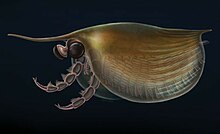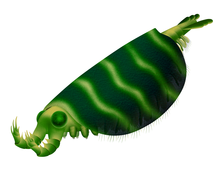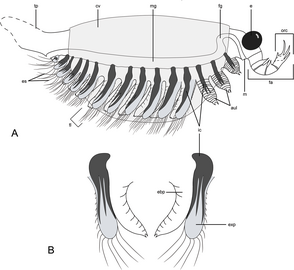Isoxyida
| Isoxyida Temporal range:
| |
|---|---|

| |
| Restoration of Isoxys curvirostratus | |

| |
| Restoration of Surusicaris elegans | |
| Scientific classification | |
| Domain: | Eukaryota |
| Kingdom: | Animalia |
| Phylum: | Arthropoda |
| Order: | †Isoxyida Simonetta & Delle Cave, 1975 |
| Family: | †Isoxyidae Vogdes, 1893 |
| Genera | |
| Synonyms | |
| |
Isoxyids are members of the order Isoxyida and the family Isoxyidae, a group of basal arthropods that existed during the Cambrian period. It contains two genera, Isoxys, with 20 species found worldwide, and Surusicaris known from a single species found in the Burgess Shale of Canada. They are distinguished by their bivalved carapaces and pair of upward curving grasping frontal appendages.
Description
Isoxyids have a combination of features seen in both stem-group arthropods, as well as more advanced taxa. Isoxyids have semicircular bivalved carapaces, large, spherical eyes, a pair of large upward curling frontal appenages covered in spines, and pairs of biramous limbs running along the body. The trunk region appears to be unsegmented and lacks sclerotisation, similar to radiodonts, with a segmented and sclerotised (arthropodized) trunk being characteristic of most arthropods.[1][2] Currently only two genera have been accepted to be members of this family. These being Isoxys, which has an almost cosmopolitan distribution, and is known from twenty species, and Surusicaris, which is limited to the Burgess shale site in British Columbia, and only contains a single species. These arthropods are thought to have been predators, hunting soft-bodied prey in either the water column, or close to the seabed.[2][3][4]
Taxonomy
| |||||||||||||||||||
This cladogram shows the relationships of the isoxyids compared to other arthropod groups, according to the results of Zhang et al. 2023.[1]
The true classification of the isoxyids has been somewhat controversial. Although they are often regarded as basal arthropods, where they actually fit into the arthropod family tree has been contested. Originally, it was thought that Isoxys was related to another bivalved arthropod from the Cambrian, Tuzoia, due to the similar aspects of their carapaces. However, a study in 2022 found that Tuzoia was a member of Hymenocarina, and that it was not closely related to the isoxyids. Currently the group has been placed into the Deuteropoda, a proposed clade of arthropods whose members are distinguished by an anatomical reorganization of the head region, including the appearance of a differentiated first appendage pair (the 'deutocerebral' pair), a multisegmented head, and a hypostome/labrum complex,[5][6][7] being placed outside the crown group of Arthropoda, with both Mandibulata and Chelicerata being more closely related to each other than to isoxyids.[1]
Ecology
Species of the Isoxydia are thought to have been actively swimming predators, using their frontal appendages to capture soft-bodied prey, with the frontalmost pairs of biramous limbs aiding in food processing.[1] The various species of the order are thought to have occupied a variety of niches, from swimming just above the seafloor (nektobenthic) to open ocean swimmers (pelagic).[4] Swimming was likely accomplished by rhythmic movement of the legs.[1] Isoxyid species with elongated carapace spines are likely to have engaged in vertical migration up and down the water column, like many modern marine invertebrates.[4]
Gallery
-
Diagram of Surusicaris
-
Diagram of Isoxys curvirostratus
-
The holotype, and only known fossil, of Surusicaris
-
Fossil of Isoxys acutangulus
References
- ^ a b c d e Zhang, Caixia; Liu, Yu; Ortega-Hernández, Javier; Wolfe, Joanna; Jin, Changfei; Mai, Huijuan; Hou, Xian-guang; Guo, Jin; Zhai, Dayou (19 April 2023). "Three-dimensional morphology of the biramous appendages in Isoxys from the early Cambrian of South China, and its implications for early euarthropod evolution". Proceedings of the Royal Society B: Biological Sciences. doi:10.1098/rspb.2023.0335. PMC 10113025.
- ^ a b Aria, Cédric; Caron, Jean-Bernard (2015-06-03). Friedman, Matt (ed.). "Cephalic and Limb Anatomy of a New Isoxyid from the Burgess Shale and the Role of "Stem Bivalved Arthropods" in the Disparity of the Frontalmost Appendage". PLOS ONE. 10 (6): e0124979. Bibcode:2015PLoSO..1024979A. doi:10.1371/journal.pone.0124979. ISSN 1932-6203. PMC 4454494. PMID 26038846.
- ^ Vannier, J.; Garcia-Bellido, C.; Hu, X.; Chen, L. (Jul 2009). "Arthropod visual predators in the early pelagic ecosystem: evidence from the Burgess Shale and Chengjiang biotas". Proceedings: Biological Sciences. 276 (1667): 2567–2574. doi:10.1098/rspb.2009.0361. ISSN 0962-8452. PMC 2686666. PMID 19403536.
- ^ a b c Pates, Stephen; Daley, Allison C.; Legg, David A.; Rahman, Imran A. (2021-06-30). "Vertically migrating Isoxys and the early Cambrian biological pump". Proceedings of the Royal Society B: Biological Sciences. 288 (1953): 20210464. doi:10.1098/rspb.2021.0464. PMC 8220267. PMID 34157876.
- ^ Ortega-Hernández, Javier (2016), "Making sense of 'lower' and 'upper' stem-group Euarthropoda, with comments on the strict use of the name Arthropoda von Siebold, 1848", Biol. Rev., 91 (1): 255–273, doi:10.1111/brv.12168, PMID 25528950, S2CID 7751936
- ^ Ma, Jiaxin; Lin, Weiliang; Liu, Cong; Sun, Ao; Wu, Yu; Wu, Yuheng; Fu, Dongjing (January 2022). "A new bivalved arthropod from the Cambrian (Stage 3) Qingjiang biota expands the palaeogeographical distribution and increases the diversity of Tuzoiidae". Journal of the Geological Society. 179 (1): jgs2020–229. Bibcode:2022JGSoc.179..229M. doi:10.1144/jgs2020-229. ISSN 0016-7649. S2CID 236289449.
- ^ Izquierdo-López, Alejandro; Caron, Jean-Bernard (December 2022). "The problematic Cambrian arthropod Tuzoia and the origin of mandibulates revisited". Royal Society Open Science. 9 (12): 220933. Bibcode:2022RSOS....920933I. doi:10.1098/rsos.220933. ISSN 2054-5703. PMC 9727825. PMID 36483757.



